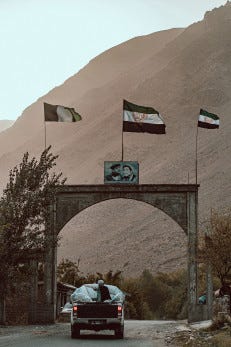“Our national unity is based on ensuring social justice.”
-Ahmad Shah Massoud, Lion of Panjshir
It has been a wild week on the ground in Afghanistan, to say the least. It has been mayhem and madness, especially when it comes to the amount of misinformation I am seeing perpetuated across the mainstream media and social media. Images of fights that took place years ago, in countries that are not even Afghanistan, are being passed for fact and stories told three persons removed are also circulated without due diligence.
It’s dizzying to wade through, and journalism no matter how hard we try will always be an imperfect science. Nonetheless, now – more than ever – I remain firmly committed to the importance of bearing witness to events as they unfold inside a country I love so deeply.
PROTESTS RAGE ON, THE TALIBAN RESPONDS WITH DISPERSAL GUN FIRE
Shortly before midday Tuesday in Kabul’s Shar-e-Naw district, hundreds of young women — joined by hundreds of men — stormed toward Afghanistan’s presidential palace in vehement protest against the Taliban’s rule.
“Death to Pakistan, death to the Taliban, death to the ones who cheated our country,” they chanted.
But as the momentum built, the Taliban dispersed the crowds in minutes by firing endless bullets into the air, prompting scores of demonstrators to flee in various directions, disappearing amid the throngs of shopkeepers and curious onlookers.
Eyewitnesses described the demonstration as comprised mostly of women, with most expressing upset toward Pakistan.
“We’re tired,” one protester lamented to me later, sheltering inside a bakery after running from authorities. “This is the only thing we can do now.”
However, Taliban intelligence authorities on the street — who belong to the group’s elite forces — offer a different take on the situation.
“We talked to some protesters, and they did not know why they were even there,” a Taliban commander told me as a cluster of his special forces gathered, stressing that they were being paid the equivalent of approximately $10 to $20 by a “special Massoud organizing group” to cause unrest.
Yet the morning’s mayhem did not deter the women. Around 3:30 p.m., another protest proliferated in the same Shahr-e-Naw district, filled almost entirely with women appearing to be in their 20s. The hundreds of women massed in small packs on street corners, armed with handwritten signs and shouting “Freedom” as they began their daunting walk into the unknown and into a potential hail of gunfire and handcuffs.
“We want what we worked so hard to achieve,” a prominent Afghan women’s rights activist who was not present at Tuesday’s commotion said. “We don’t care if it costs us our lives. We have no life anymore as this is.”
READ MORE ABOUT THE ONGOING PROTESTS HERE
INSIDE EMERGENCY: KABUL’S HOSPITAL FOR THE WAR WOUNDED
It is a place as necessary as it is tragic: a fortified hospital in the center of Kabul, brimming with broken bones and bullet-battered children, those who have lost limbs and loved ones in the bloodshed that has gripped Afghanistan.
It’s run by the Italy-based NGO EMERGENCY (of which I am a proud board member).
One of the most prominent problems EMERGENCY has encountered since the Taliban takeover is the group’s celebratory shooting in the air. On Friday, the rapid gunfire injured 12 – two of them children. One of the injured children, around 7 years old, was admitted with a bullet to the back of the head, and the other boy – age unknown – was hit in the chest. Both are fighting for their lives.
After complaints to the Public Health Ministry, Taliban authorities announced a public ban on such behaviors.
The halls and quiet wards of EMERGENCY, founded in 2000 under the first Taliban rule in Afghanistan, are an amalgam of fear, misery, and triumph. A child who sustained a head injury in a blast calls out to his mother in wincing confusion and yelps like a wounded animal, and a blinded man reaches out into nothingness – exposing arms healed with deep layers of pink.
Another young person, with a hollowed chest and protruding cheekbones, vacillates between anguish and laughter. His name is Abdul, and he thinks he is about 14 or 15, although EMERGENCY staff predicts his actual age is probably closer to 18. Only there is no official birth record, and it is likely that nobody will ever really know. Abdul lost both his legs days ago to a landmine in Logar province, yet he smiles and folds his fragile body into prayer, accepting his new reality with a beleaguered shrug.
Yet several other young men – all in their twenties – tell me they were shot in disputes with people they knew near their homes on the edges of the city over the past two weeks, highlighting the area’s maneuver away from war and into an uptick of violence and crime.
Sadly, some patients are haunted by having become burdens on their already low-income families. They worry that they can no longer provide and will require medical attention and constant, financially-draining help for the rest of their lives.
READ MORE ABOUT MY TOUR INSIDE EMERGENCY IN A TALIBAN WORLD HERE
SEPTEMBER 11: 20 YEARS LATER
The 20th Anniversary of September 11 struck a deep chord, as I am sure they did with almost every American whether they were alive when the tragedy unfolded or not.
The memory of what we were doing and what we were thinking when we heard about the 9/11 attacks is planted in our graveyard of memories. Twenty years ago, I was a high school student cocooned by books and ballet classes and boyfriends, watching my tiny television in fear that the whole world was crashing. Still, I did not know then what impact Afghanistan — the land on the edges of the earth where the horrible plot was brought to life by al-Qaeda — would come to have on my life, not just personally but professionally too.
But in the elastic years after the 2001 attacks, after U.S. forces usurped the Taliban regime from power, it was hard for me to process how and why the list of lost limbs and lives from that day kept piling up.
“They are bombing al-Qaeda,” a weeping woman once said to me after losing her husband in an attack in the eastern edges of the country. “But they are bombing my people too.”
Every Afghan has a war story, even though almost all of them never chose to go to war.
Even now, Afghanistan’s younger generation — who know nothing but conflict — aren’t entirely sure what it has all been about. The day before the northern city of Mazar-e-Sharif, the place where the U.S. first entered in the 9/11 aftermath, fell to Taliban control last month, college students looked at me quizzically when I asked if they knew about Osama bin Laden.
“No,” one 22-year-old said, cocking his head and staring at me strangely. “Who is this?”
READ MORE ABOUT HOW AFGHANS REMEMBER 9/11 HERE
STUMBLING UPON THE TALIBAN’S SECRET ‘SUICIDE SQUAD’
Stuffed toys languish on a shelf near the building’s entrance. Playground equipment remains dead still beside Taliban uniforms draped over the playpen fence to dry: glaring reminders of the nursery school that existed inside the faded pink walls just 10 days earlier.
The former school now serves as the new base of the Taliban’s elite special forces unit known as Badri or the “Badri Command.” But it is not only home to the hardest of hard fighters, who roam the grounds clad in camouflage and touting an arsenal of American-made weapons, it is also for those training to become suicide – or martyrdom – bombers too.
“This Command has two parts,” one high-ranking fighter, whose name I later learn is Hafiz Badry, tells me in a low voice. “There are those who train to be special forces fighters and those who train to be special suicide bombers.”
The battalion is heavily equipped with state-of-the-art American equipment, including camouflage uniforms, body armor, Humvees, night-vision goggles, M4 carbines, and M16s. For their sidearms, the men carry shiny new Glocks and 1911 hand pistols.
One has to “have done special actions designed for this command” before being picked for training, Badry explains.
As for the suicide bombers, he and a fellow top fighter, Kari Omadi Abdullah, 26, concur that they are overwhelmed with those wanting to be chosen for that esteemed cadre.
“It is not about the picking in this case. It is about the eagerness,” Badry says with enthusiasm. “There are some fighters who even come to us crying and begging, asking why we don’t pick them for the suicide squad.”
The men say that training lasts between 40 days and six months, depending on the mission, and involves intensive tactical work and religious studies.
While the fighters are now echoing a message of “peace” in the conquered country, there is no indication that the suicide school will cease. The men also made it clear that their heavy weaponry and building up the air force is the next focus on the item agenda.
“We are going to be concentrating our training on the big arms, as well as the helicopters, jets, whatever is available,” Omari goes on. “We are training on these to show the world that we can do it.”
READ MORE BEHIND-THE-SCENES OF THE SUICIDE SQUAD HERE
AN INSIDE LOOK AT TALIBAN-RUN PANJSHIR, AFGHANISTAN
Mist swirls around the undulating mountains dotted with mud huts, and emerald waters trickle through the narrow, pebble-filled canals. On the surface, Panjshir Valley is a picture of serenity. But one cannot help but feel the uncertainty and tension hidden in the hills.
As we traveled through all eight districts on Friday – under the eye of the Taliban – it seems clear, despite mixed reports and confusion in the past week over whether Panjshir had fallen, that Afghanistan’s new ruling power has secured an undoubtedly tight grip.
Dozens of robed Taliban fighters congregate outside the Panjshir Revenue Department. They all hail from Farah province some 500 miles away and belong to a unit rapidly deployed to places as necessary. Taliban commander Mawlawy Khalid claims that all of Panjshir was fully seized three days earlier, but many Panjshiris have fled to the mountains.
“We will give them a deadline, today or tomorrow or whenever (to surrender),” Khalid said, adding that whoever does not surrender “they shoot them dead.”
The process of surrender, according to Khalid, is that once weapons have been checked and handed over, the individual is then issued “a letter” indicating that they are “free” to return home as normal.
There are roughly 8,000 Taliban members now stationed throughout Panjshir, however the main artery of the province – while almost entirely shuttered and abandoned – appears free from destruction. Still, frightened families are still fleeing. We spot a van stuffed with people and piles of belongings strapped to the top in one case. Taliban Commander Hussein Ahmad waves the driver over – his face ashen with apparent nerves – to ask why they are leaving and vowing that the Taliban will not hurt them.
“Everyone has gone; our families have gone to Kabul,” the man says. “But maybe we will be back.”
Despite the heavy Taliban presence from the beginning to end, many analysts point out that the next few weeks are crucial in determining the outcome of the National Resistance Forces (NRF). The Panjshiri tribal leader, Ahmad Massoud – the son of Ahmad Shad Massoud, who was assassinated by al-Qaeda two days before the September 11 attacks – has remained firm in his call to keep fighting.
And finally, for a strange observation: on Thursday I saw a Talib outside the (old) US embassy in the heart of Kabul donning a Trump 2024 cap. When I asked him why, he had no idea. The other Talibs then started making fun of him. What proceeded next was a dramatic ripping of the patch to the ground.
Truth is stranger than fiction. While it appears that the Embassy remains abandoned on the inside, the outside is stripped of its former life and murals and is entirely painted over with the jarring white-and-black Islamic Emirate of Afghanistan flag.
Follow me on Instagram and Twitter for more updates
Photos courtesy of my brilliant photographer @JakeSimkinPhotos.


















Share this post